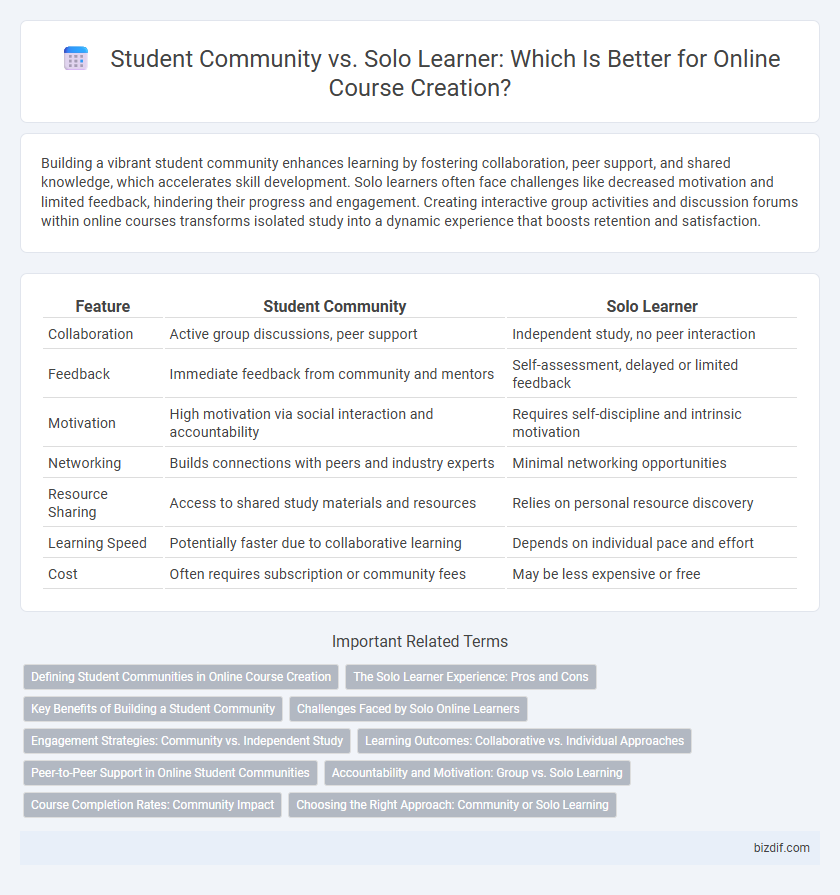Building a vibrant student community enhances learning by fostering collaboration, peer support, and shared knowledge, which accelerates skill development. Solo learners often face challenges like decreased motivation and limited feedback, hindering their progress and engagement. Creating interactive group activities and discussion forums within online courses transforms isolated study into a dynamic experience that boosts retention and satisfaction.
Table of Comparison
| Feature | Student Community | Solo Learner |
|---|---|---|
| Collaboration | Active group discussions, peer support | Independent study, no peer interaction |
| Feedback | Immediate feedback from community and mentors | Self-assessment, delayed or limited feedback |
| Motivation | High motivation via social interaction and accountability | Requires self-discipline and intrinsic motivation |
| Networking | Builds connections with peers and industry experts | Minimal networking opportunities |
| Resource Sharing | Access to shared study materials and resources | Relies on personal resource discovery |
| Learning Speed | Potentially faster due to collaborative learning | Depends on individual pace and effort |
| Cost | Often requires subscription or community fees | May be less expensive or free |
Defining Student Communities in Online Course Creation
Student communities in online course creation are groups of learners who actively engage, collaborate, and support each other throughout the course journey. These communities enhance knowledge retention and motivation compared to solo learners by fostering peer interaction, shared experiences, and collective problem-solving. Platforms that integrate discussion forums, live group sessions, and social networks effectively build these interactive learning environments.
The Solo Learner Experience: Pros and Cons
The solo learner experience in online course creation offers personalized pacing and deep focus, allowing individuals to tailor content consumption to their unique needs. However, the absence of a student community may lead to limited peer interaction, reduced motivation, and fewer opportunities for collaborative problem-solving. Solo learners benefit from flexibility but often face challenges in maintaining accountability and gaining diverse perspectives essential to comprehensive understanding.
Key Benefits of Building a Student Community
Building a student community in online course creation enhances engagement through peer support and collaborative learning, boosting retention rates by fostering a sense of belonging. Access to diverse perspectives and real-time feedback accelerates knowledge application and problem-solving skills. Increased motivation and accountability within the community lead to higher course completion rates compared to solo learners.
Challenges Faced by Solo Online Learners
Solo online learners often struggle with limited peer interaction, resulting in decreased motivation and engagement compared to those in a student community. The absence of collaborative feedback and real-time support can hinder comprehension and slow progress. Furthermore, solo learners frequently face challenges in maintaining accountability and managing time effectively without the social structure of a community.
Engagement Strategies: Community vs. Independent Study
Student communities foster higher engagement through peer interaction, collaborative projects, and real-time feedback, enhancing motivation and knowledge retention. Solo learners benefit from personalized pacing and tailored study plans, but often face challenges in maintaining discipline and engagement. Incorporating forums, live Q&A sessions, and social learning tools boosts active participation in community settings, while solo study thrives with structured milestones and self-assessment techniques.
Learning Outcomes: Collaborative vs. Individual Approaches
Student communities enhance learning outcomes through collaborative problem-solving, peer feedback, and diverse perspectives, fostering deeper understanding and retention. Solo learners benefit from individualized pacing and focused study, enabling mastery of material tailored to personal needs. Both approaches impact knowledge acquisition differently, with community learning promoting critical thinking and solo study supporting self-discipline and autonomy.
Peer-to-Peer Support in Online Student Communities
Peer-to-peer support in online student communities enhances learning outcomes by fostering collaboration, knowledge sharing, and motivation among members. Engaged communities offer real-time feedback, diverse perspectives, and accountability that solo learners often lack, leading to improved retention and skill mastery. Platforms with active discussion forums, group projects, and social interaction tools create a dynamic environment that supports continuous growth and problem-solving.
Accountability and Motivation: Group vs. Solo Learning
Student communities foster higher accountability and sustained motivation through peer interaction, shared goals, and collaborative problem-solving, which often lead to improved course completion rates. Solo learners rely heavily on intrinsic motivation and self-discipline, making consistent progress more challenging without external support or feedback. Platforms that integrate community features or mentor support tend to enhance learner engagement and success compared to isolated study environments.
Course Completion Rates: Community Impact
Student communities enhance course completion rates by fostering peer support, accountability, and motivation, leading to higher engagement levels compared to solo learners. Studies show that learners involved in interactive forums or group activities are 2-3 times more likely to finish courses successfully. This social interaction not only boosts commitment but also facilitates knowledge retention and practical application.
Choosing the Right Approach: Community or Solo Learning
Choosing the right approach in online course creation hinges on understanding the benefits of student communities versus solo learning. Student communities enhance engagement and knowledge retention through peer interaction, collaboration, and shared experiences, which can boost motivation and accountability. Solo learners benefit from personalized pacing, allowing deeper focus and flexibility, but may face challenges in maintaining motivation without community support.
Student community vs Solo learner Infographic

 bizdif.com
bizdif.com